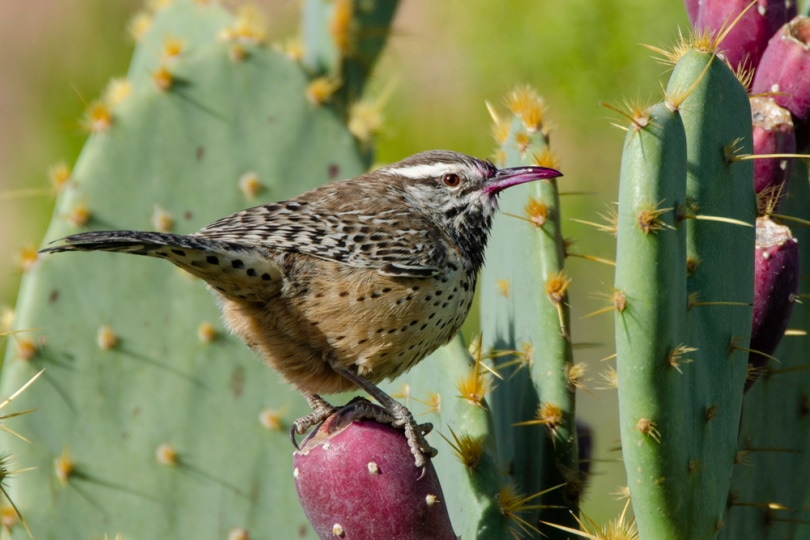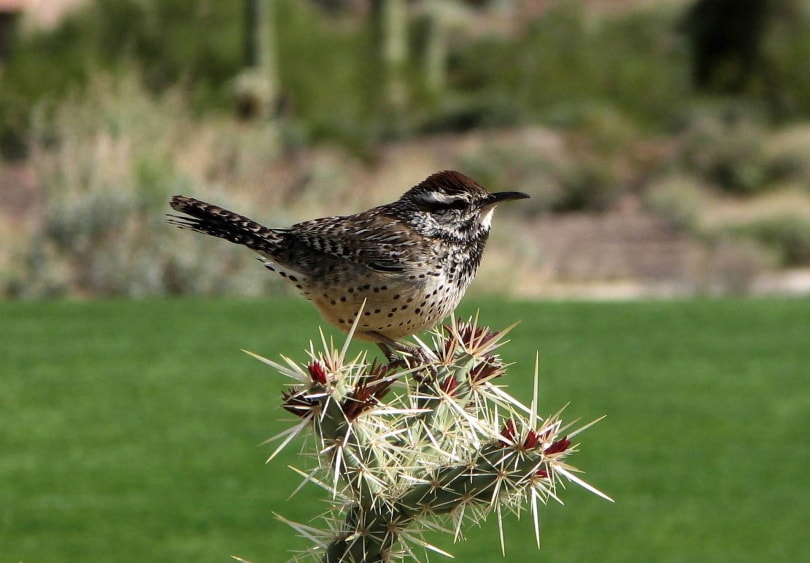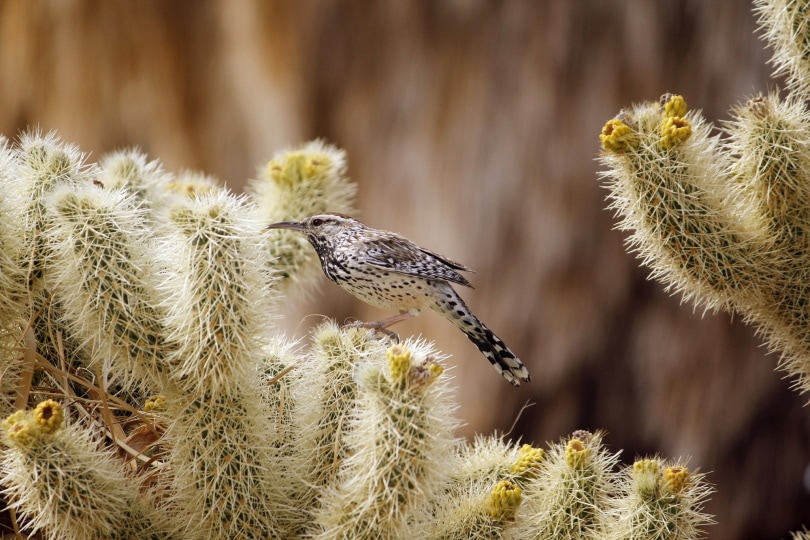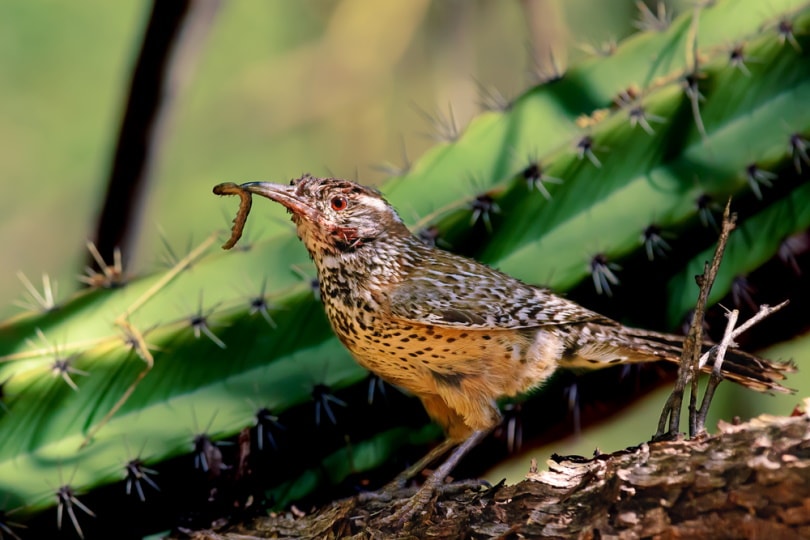What is Arizona’s State Bird? How It Was Decided?
Last Updated on

Arizona, the Sun Devil State, is nestled by Nevada and California in the Southwestern United States. Southern Arizona is known for its brilliant desert climate and scenery, while the North is forested and mild. Arizona is unique not just for its mix of climates and scenery but because it is one of the few states to have an individual, unique state bird. While all states have an official state bird, 30 states share their chosen bird with another state. Arizona is just one of the twenty states that have a unique choice.
The Campylorhynchus brunneicapillus, or the cactus wren, was officially chosen as the state bird in 1931. While the other North American wrens are small and shy, the cactus wren is as large and prickly as its namesake. It is the largest of the North American wrens and is big, boldly patterned, boisterous, and curious.
At 8 inches, the cactus wren dwarfs the others, and its borderline bullying behavior makes it hard to ignore. The cactus wren flourishes in the bone-dry environment of the desert and enjoys national protection despite not being classified as endangered.

Why Was the Cactus Wren Chosen as Arizona’s State Bird?
Arizona chose its state bird in 1931, 19 years after Arizona became a state. Arizona has designated state symbols, like a state gun (Colt Single Action Army Revolver) and a state gem (turquoise). While there are many stories surrounding the adoption of the cactus wren as the state’s bird, including the rumor that the bird’s song was similar to the “babble” from a state legislative session, the real story is likely a combination of the rumors.
Both the 1932 edition of Nature Magazine and 1931 edition of Arizona Wildlife claim the state launched a campaign in 1931 to vote on the state bird. The native, outgoing, and attention-grabbing cactus wren captured the hearts of the voters. This big, bold bird has earned quite a reputation since then.

What Does the Cactus Wren Look Like?
As the largest species of the wren family, the cactus wren stands tall at 7 to 9 inches tall. These little giants are easily spotted by their white, brown, and black-barred tails and wings, white eye stripes on their brown heads, brown and black spotted bellies, and slightly curved bills.
Male and female cactus wrens have similar physical features, but the young are significantly duller in color with darker heads. The cactus wren shares many of its physical traits with the other wrens, but it is distinguished by its white tail band that only extends while in flight.
It isn’t a very long bird, but its length ranges from 7.1 to 7.5 inches. The cactus wren’s wingspan is a bit more impressive, ranging from 8 to 10 inches long. These little birds don’t weigh very much, thanks to their size, and they usually live 7 or 10 years old in the wild.
Where Does the Cactus Wren Live?
The cactus wren thrives in dry, desert environments ripe with cacti and insects. Large populations of the wrens live in the Mojave and the Sonoran Desert regions. Cactus wrens typically make their homes in cacti, hence their name. You can find these birds in areas rich with the Saguaro cactus, mesquite, and yucca plants.
For the cactus wren, cactus plants provide the perfect form of shelter and food in the desert’s harsh conditions.
The choice of cactus is vital to the birds’ survival because they do not migrate. These ferocious flyers create permanent territories they settle in for life. They are staunch defenders, and they protect their chosen habitats from predators and other birds.
During the breeding season, a male wren will build two nests nearby to act as decoys in order to keep snakes and other predators away from the actual nest. The cactus wren’s nest is about the size of a football and is hidden away in the cactus’ interior.

How Does the Cactus Wren Behave?
The cactus wren mates for life, and it creates a permanent territory to defend its family from other predators. Wrens are not to be trifled with, especially near their chosen nesting areas.
They will attack squirrels, other birds, and snakes that get too close to their nest. They will even destroy the nests of other birds in the area to eliminate competition for food and force them out of the area.
. While wrens are menacing, they don’t often have to fight because they scare away other birds and would-be predators by fluffing their feathers out to make themselves bigger.
Cactus wrens are not shy by any means, and they have been known to even fly into open windows of cars or nearby homes within their territories out of sheer curiosity.
What Does the Cactus Wren Eat?
Cactus wrens are naturally insect eaters, but they will also take fruits, seeds, nectars, and even small reptiles. They prefer insects like ants, grasshoppers, and beetles. Cactus Wrens eat in the early mornings, and they move to cooler areas in order to digest their meals, conserve water, and thermoregulate their body temperatures. If there are no bugs around, or their insect hunting grounds are barren, these ingenious birds have even removed dead insects smashed into peoples’ cars.


Fun Facts
- Cactus wrens received their name because of the way they build their nests within cactus plants in their habitats.
- The loud raspy chirrup song of cactus wrens is described by some ornithologists as a rusty car engine struggling to start or a loud motor stuttering. Their calls are so loud that the sound can be heard 300 meters (1,000 ft) away.
- Since male and female cactus wrens are identical, they are identified through their behavior. Male cactus wrens are more aggressive, and females are better vocalists.
- Cactus wrens are weak fliers. They prefer to hop or walk when disturbed rather than flying away.
The cactus wren is as unique as the state it has been chosen to represent. With a voice and behavior that screams for attention, the cactus wren stands tall in its position as Arizona’s state bird. This bully of the desert is easy to recognize and has become a popular mascot for schools in Arizona. Though these birds are widespread, they can be relatively uncommon. They are typically unafraid of humans and will visit backyards where the habitat is appropriate, especially if ground feeders have bread or apple slices. Keep your eyes peeled!
Featured Image Credit: Sean R. Stubben, Shutterstock
About the Author Samantha Reed
Samantha has been a freelance writer since 2014. Samantha wrote full time while in school, and continues her passion for writing while working as a full-time educator. She currently teaches Middle School English Language Arts and always encourages writing activities in her classrooms. If she is not writing, you can often find her reading or binge watching another Netflix series and spending time with her cat, Raven.
Related Articles:
10 Types of Hummingbirds in Arkansas (With Pictures)
8 Types of Hummingbirds in Nebraska (With Pictures)
5 Types of Hummingbirds in Idaho (With Pictures)
3 Types of Hummingbirds in Mississippi (With Pictures)
8 Types of Hummingbirds in Kansas (With Pictures)
5 Types of Hummingbirds in West Virginia (With Pictures)
5 Types of Hummingbirds in Ohio (With Pictures)
Where Do Nuthatches Nest? Nuthatch Nesting Habits Explained
